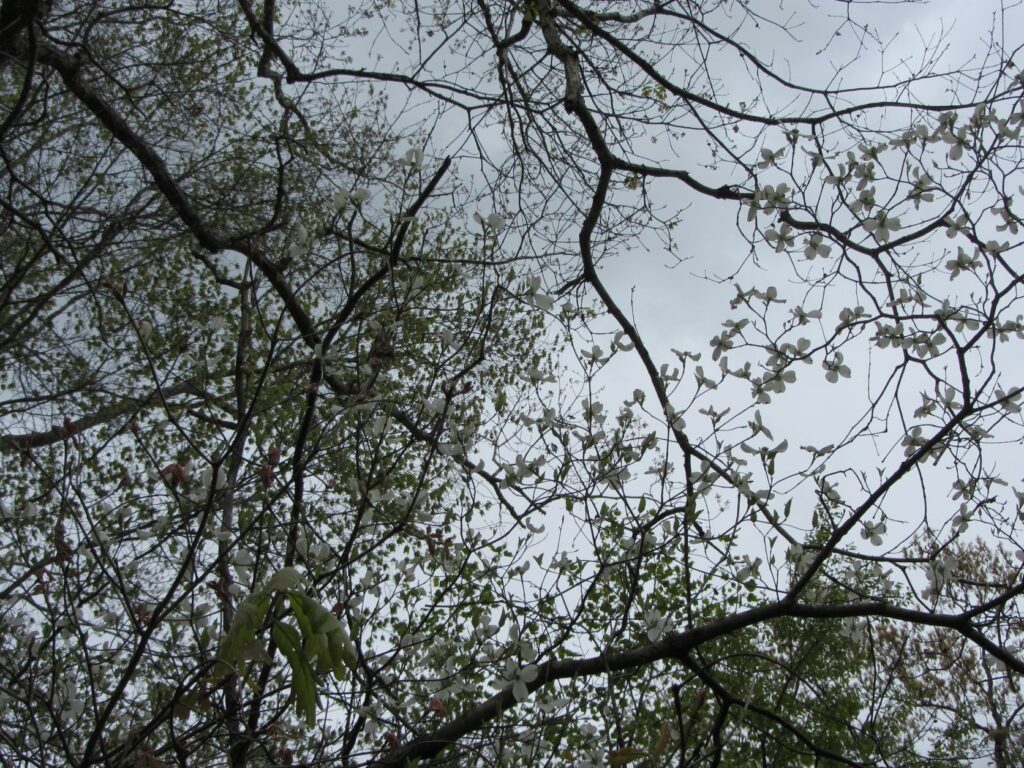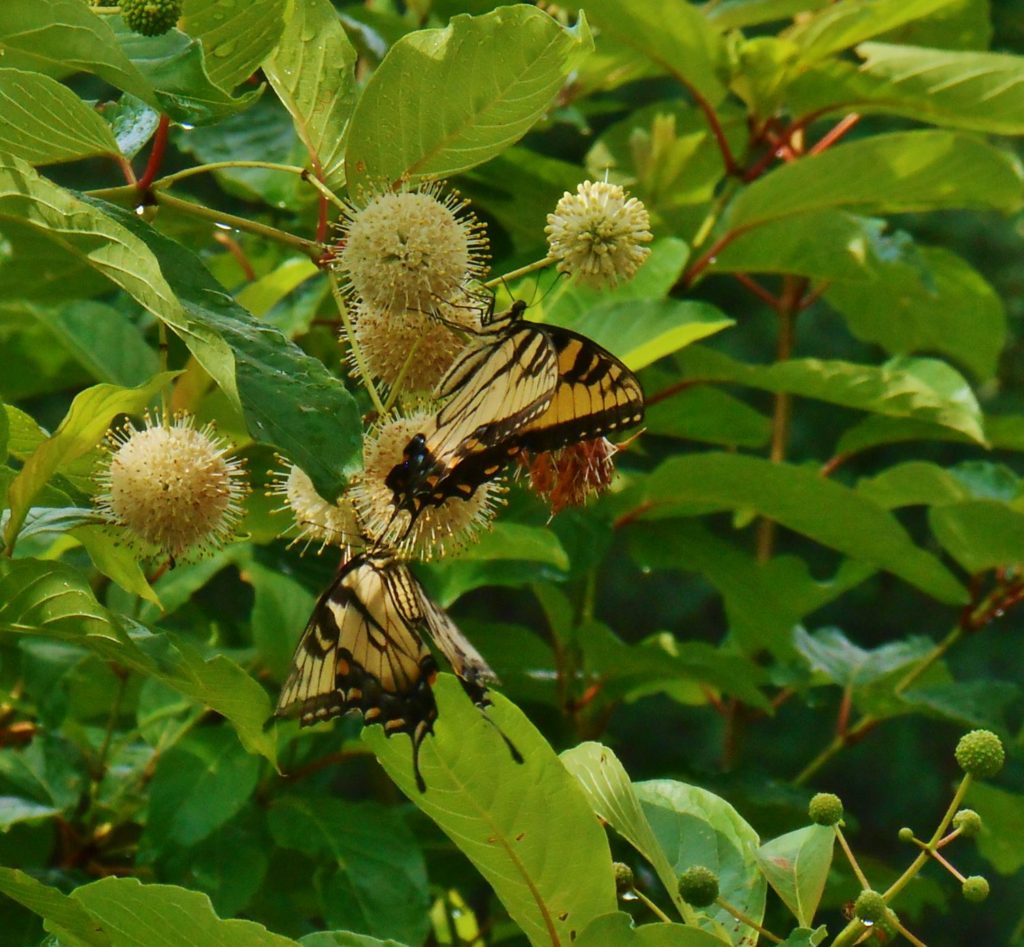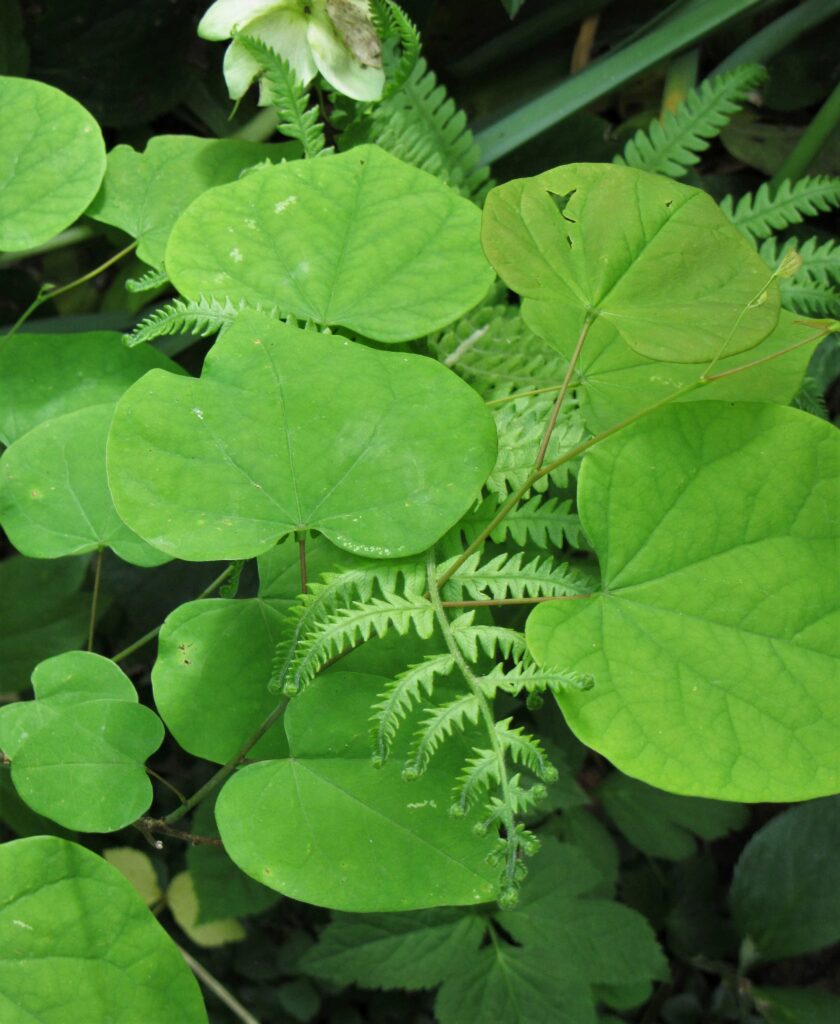Part 2: PNV: Potential Natural (Native) Vegetation
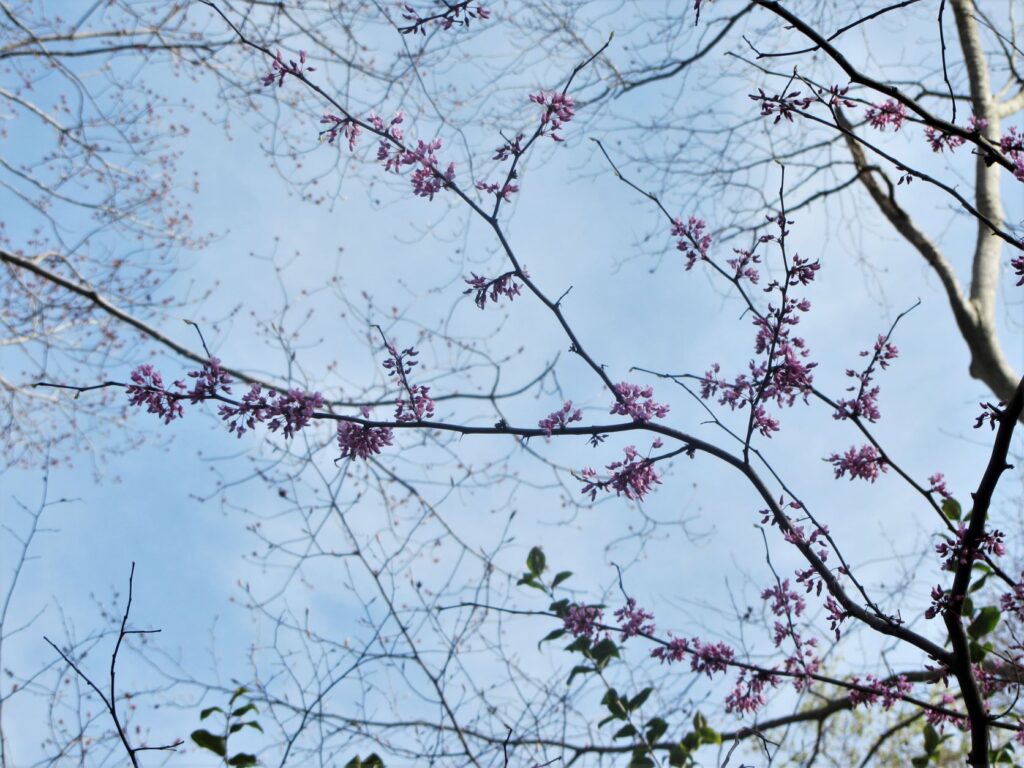
Eastern redbud, Cercis canadensis, is one of the earliest native trees to bloom each spring. Edible seedpods follow months later.
Appropriate Species for Tiny Forests in Eastern Virginia
Tiny forests designed following the Miyawaki method include a wide variety of native trees, shrubs, and ground covers planted randomly and densely, varying the heights of trees to establish a canopy layer, intermediate layers, and a ground cover layer. Plant as many as 3 to 5 plants per square meter into the prepared soil. Plants grow quickly, reaching for the light. A forest that takes a century or more to develop through natural succession can be established in a few decades using this method.
Forest Disturbance Determines Species Distribution
American beech, hickory trees, and several species of oak comprise the climax forest community in the Williamsburg area. Chestnut trees were also a part of the climax community before they succumbed to the pathogenic chestnut blight fungus in the early 20th century. Captain John Smith commented on the dominance of oak and hickory trees in Virginia’s forests. Oak and hickory trees survived the wildfires of earlier eras while the beech trees, with their thinner bark, could not. American beech is more long-lived than either oak or hickory trees and produces dense shade. Beech trees often shade out other nearby seedlings or crowd them out with new trees growing from suckers on their vast root systems. This leaves American beech as the natural primary species in the oldest stands of forest in our region.
Remaining forests in the Williamsburg area are all second growth or even third or fourth growth forests at this point in our history, and all shows signs of human disturbance. Before around 1940, periodic wildfires shaped the forests. This is a rare occurrence now. At one time, deer were virtually eliminated from the coastal plain of Virginia, which allowed many tree species to flourish that are rarely seen now. Grazing by the burgeoning deer population in our area today prevents most trees and other understory seedlings from maturing. Once common trees like dogwood, red maple, blackgum, and crabapple are disappearing from our forests because of relentless grazing. Many of our remaining forests experienced selective logging at some point in their history. And once healthy trees regularly succumb to various insects and microbial pests unknown even fifty years ago in our area.
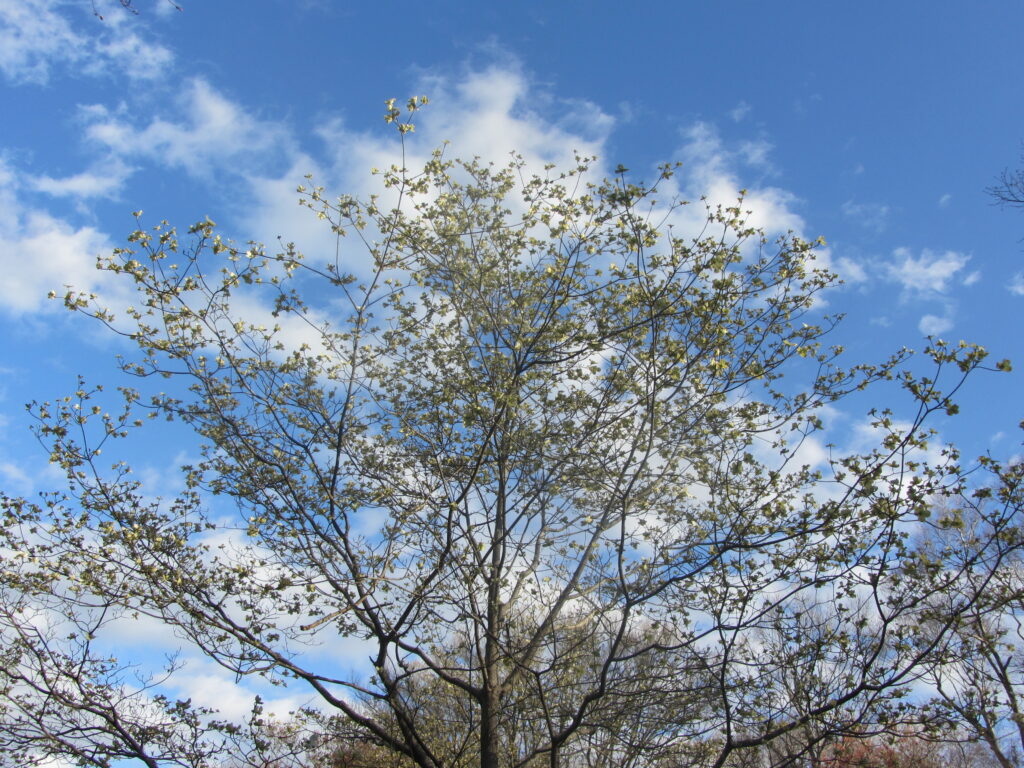
Flowering dogwood, Cornus florida, requires protection from grazing deer during its first few years of growth.
Soil Moisture Influences the PNV
The forests growing in upland, well-drained areas are composed of different trees than those growing in lowland areas with wetter, poorly draining soils. Even the same tree species, like red maple, will grow differently depending on available moisture and sunlight. Some trees tolerate growing near brackish water while others do not. Some are fine growing in water left standing for days or weeks after storms and high tides, while others will die of root rot in saturated soils. Preferences for upland or lowland environments are indicated in the notes on each species.
Additional Considerations
Forests which include trees bearing edible and medicinal nuts, fruits and berries, leaves, and bark can be cultivated as ‘food forests.’ Plant multiples of trees for cross-pollination, and both a male and females of dioeceous trees. Plant fruit trees like crabapple, black cherry or persimmon near the edges of the planting where they will get more sunlight. Too much shade will delay and reduce flowering and fruit production. Even in perfect conditions, trees often need a decade or more to begin producing fruit and nuts.
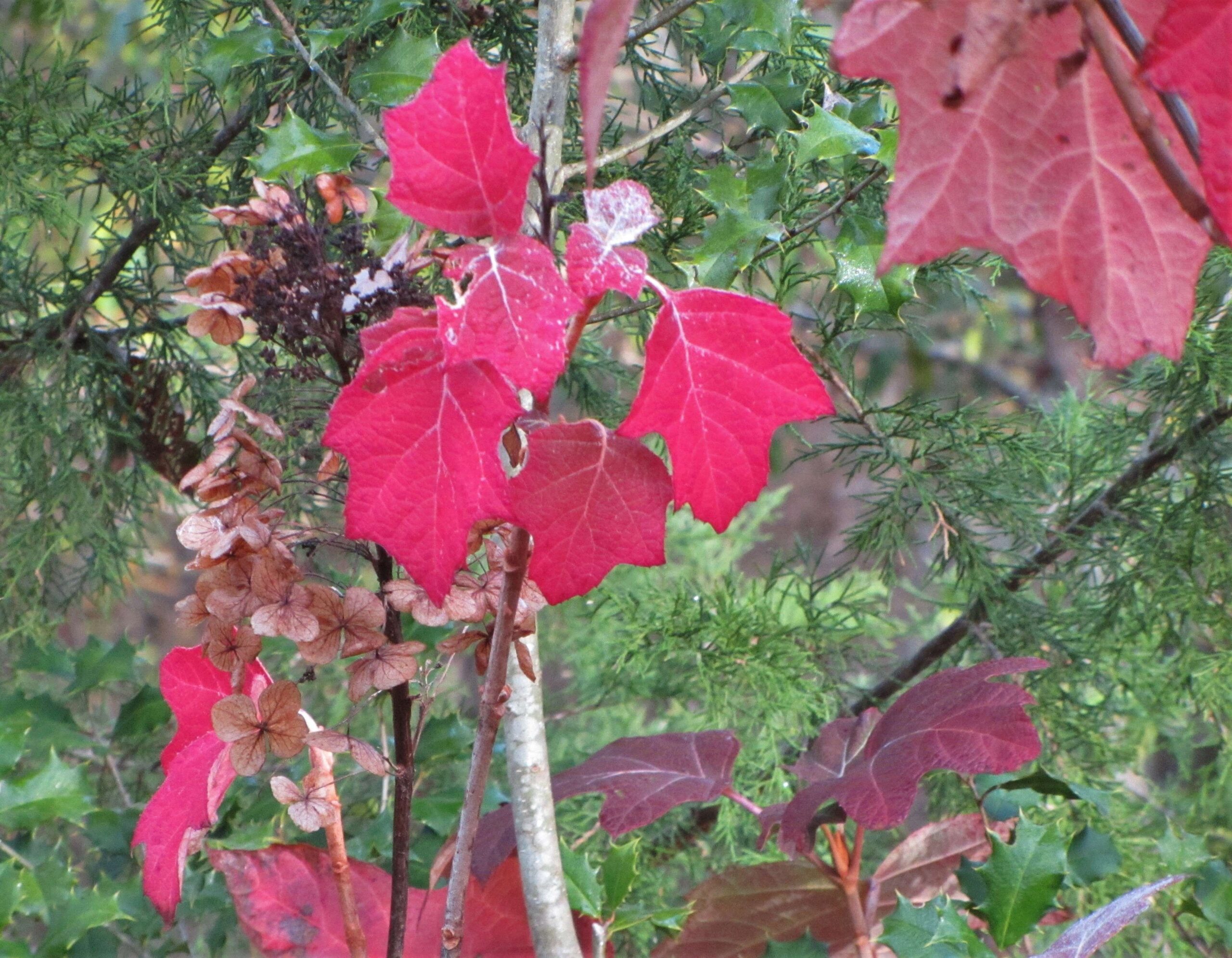
Oak leaf Hydrangea, Hydrangea quercifolia grows against an evergreen backdrop of Eastern red cedar and American holly. December, 2022
Include evergreens or plants with interesting bark for winter beauty. Many of these varieties are highly ornamental with beautiful flowers, bark, fall foliage, and fruit. Some varieties grow as multi-stemmed shrubs that expand with age, while others naturally sucker and spread. Take this horizontal expansion into account when originally spacing plants.
Trees provide habitat and food for wildlife throughout the year. Many of these native trees and shrubs serve as host plants for moths and butterflies. Even very small guilds of trees offer nesting sites, places to shelter from the weather, and a resource where birds and small mammals can hunt for insects and larvae. A tiny forest planting becomes a magnet for wildlife, greatly increasing biodiversity and helping to support endangered and declining wildlife populations.
Forests Enrich Our Lives
Even a small plot of land planted in the Miyawaki style produces a beautiful small forest filled with useful and interesting plants. It provides shade, filters the air, offers privacy, and helps to control erosion. Trees improve the quality of our lives in many ways as they encourage us to relax, listen to the birds singing, and connect with the changes that each season brings.
With many thanks to Dr. Stewart Ware, Professor Emeritus at William and Mary, and Dr. Donna Ware, Emeritus Research Associate Professor at William and Mary, for their collaboration on the information about forests in our area, their assistance in selecting which species to highlight, and for the information they contributed to the notes on each species.
See Part 1, Cultivating a Tiny Forest, for information on how to design and plant your tiny forest
Find more information in these resources:
Native Plants for Southeast Virginia A guide which showcases many attractive varieties of plants native to Southeast Virginia, which includes the Hampton Roads region. It includes information about how each plant supports wildlife.
Which Tree Should I Plant? A guide was produced by the Upper and Middle James Riparian Consortium to educate Virginians about the woody native plants of our riparian areas.
The North Carolina Extension Gardener Toolbox
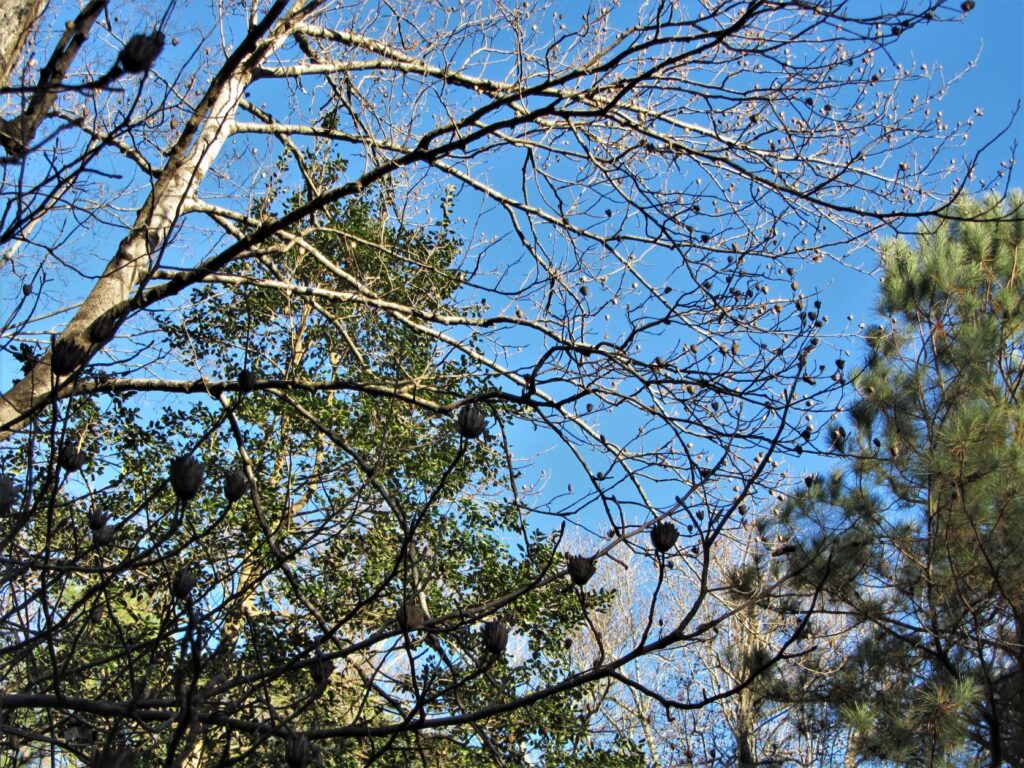
Seed capsules persist through the winter on tulip trees, Liriodendron tulipifera. This is one of the tallest trees native to our region.
Tall Trees 80’+
Acer rubrum, Red Maple, to 40’-120’, blooming, attracts pollinators, red fall color, larval host plant, medicinal, excellent for wildlife. Red maple grows best in moist soil, where it attains it greatest height. It will grow slower on upland sites. Protect from grazing deer, who love maple leaves. This tree rarely grows to maturity in areas where deer can graze its seedlings.
Carya cordiformis, Bitternut Hickory, 50′-100′, prefers sunny wetland locations and needs moist soils, nuts are edible and are also consumed by wildlife, yellow fall color, deep taproot, good shade tree, long-lived to 200 years or more, excellent for wildlife
Carya pallida, Sand Hickory, 60′-100′, grows in dry, sandy or gravelly soil, nuts consumed by wildlife, larval host plant, deep taproot, good shade tree, excellent for wildlife
Carya tomentosa, Mockernut Hickory, 60’-100’, produces edible nuts, larval host plant, yellow autumn color, excellent for wildlife
Fagus grandifolia, American Beech, 60’-80+” tall, attracts pollinators, produces edible nuts, coppery fall foliage, light grey, smooth bark, winter interest, seeds feed wildlife in winter, excellent for wildlife, medicinal uses. Beech trees produce dense shade and huge root systems, generally out competing any trees growing nearby. These are very long-lived trees and comprise the climax forest community in this area.
Liriodendron tulipifera, Tulip tree, 70’- 150’, light grey bark, blooms in early summer, attracts pollinators and hummingbirds, larval host plant, gold fall color, winter interest, seeds feed wildlife in winter, excellent for wildlife. Tulip trees grow very quickly in good sunlight, much like pines, and will quickly shade out other seedling trees nearby. This is a successional species, not part of the climax community in this region.
Platanus occidentalis, American Sycamore, 75’-100’, performs best in riparian areas with consistently moist soil in full sun where it grows quickly, may need irrigation when planted in upland areas, white and grey exfoliating bark, interesting fruit balls that linger after its leaves fall, winter interest, excellent for wildlife
Quercus alba, White Oak, 80′-130+’, the most abundant hardwood tree in coastal and Piedmont forests, larval host plant, produces acorns, fall color, medicinal uses, excellent for wildlife
Quercus falcata, Southern Red Oak, 60′-100′, the second most abundant hardwood tree in coastal and Piedmont forests, larval host plant, produces acorns, fall color, excellent for wildlife
Quercus phellos, Willow Oak, 100’, tolerates wet soil and was originally found mainly in riparian areas, fast growth, smaller leaves make fall clean-up easier, larval host plant, excellent for wildlife.
Quercus rubra, Northern Red Oak, 75’-100’, fast growing, transplants easily, tolerates dry soil, larval host plant, produces acorns, red fall color, excellent for wildlife (This oak species may have alleopathic properties to discourage growth of other nearby plants.)
Quercus velutina, Black Oak, 50′-100′, tolerates moist soil and is drought tolerant, prefers full sun, larval host plant, produces acorns, red fall color, excellent for wildlife

Native crabapple, Malus angustifolia, in bud at the Williamsburg Botanical Garden and Freedom Park Arboretum
Medium Trees 20’-80’
Amelanchier canadensis, Shadbush or Serviceberry, 15’-30’, clumping, blooming, edible fruit, larval host plant, red-orange fall color, excellent for wildlife
Asimina triloba, Pawpaw, 6′- 25’, grows tallest in sun but will grow as a shrub in dense shade, blooming, edible fruit, larval host plant, prefers moist soil, excellent for wildlife, medicinal uses, yellow fall color, suckering to form thickets
Betula nigra, River Birch, 40’- 70’, a wetland tree usually found in riparian areas, grows quickly in full sun, white to brown exfoliating bark, larval host plant, yellow fall foliage, winter interest, excellent for wildlife
Carya glabra, Pignut Hickory, 60’-80’, produces edible nuts, larval host plant, yellow autumn color, excellent for wildlife
Cercis canadensis, Eastern Redbud, to 25’-30’, an understory tree that can grow in upland areas in partial shade, showy blooms in late winter, attracts pollinators, forms edible seed pods, fixes nitrogen in the soil, larval host plant, yellow fall color, deep taproot, excellent for wildlife.
Chionanthus virginicus, White Fringetree, 15’-30’, an understory tree that can grow in upland areas in partial shade, blooming, attracts pollinators, blue-black fruits produced on female trees, yellow fall color, excellent for wildlife, plant multiple trees to produce fruits
Cornus florida, Flowering Dogwood, 20’-25’, an understory tree that can grow in upland areas in partial shade, blooming, attracts pollinators, larval host plant, requires protection from deer, produces red drupes in late summer, scarlet fall color, winter interest
Diospyros virginiana, American Persimmon, 30’-80’, deep roots control erosion, grows in upland areas, tolerates some shade, female plants produce edible fruit, larval host plant, excellent for wildlife, plant several trees for fertilization, medicinal uses
Hamamelis virginiana, Witchhazel, to 15’-30’, clumping, tolerates shade in upland areas, winter blooming, attracts pollinators, medicinal uses, excellent for wildlife
Ilex opaca American Holly, 40’-60’, broadleaf evergreen, grows in upland areas and tolerates poor, dry soil, tolerates shade, the most abundant understory tree in our area, larval host plant, attracts pollinators, produces red drupes important to birds, requires both male and female trees to produce fruit, winter interest, excellent for wildlife

Native persimmon, Diospyros virginiana, produces a smaller fruit than the Asian persimmon. These are good to eat after the first frost when they taste sweeter. Plant their seeds immediately to grow the next generation of persimmon trees.
Juniperus virginiana, Eastern Red Cedar, 30’-40’, evergreen conifer, larval host plant, fragrant, reddish exfoliating bark, winter interest, blue ‘cones’ in fall on female trees feed birds, excellent for wildlife. Red cedar isn’t categorized as a forest tree, partly because it needs good sunlight to thrive. These trees often die young when growing in the shade of a forest.
Magnolia virginica, Sweetbay Magnolia, 12’-30+’, prefers moist soil with good drainage, will tolerate shade in upland areas, grows best in sun, blooming, attracts pollinators, larval host plant, cones filled with red seeds in autumn, semi-evergreen, winter interest, excellent for wildlife
Malus angustifolia, Southern Crabapple, 20’-30’, tolerates shade in upland areas, slow growing in the shade, blooming, attracts pollinators, produces edible fruit, excellent for wildlife, plant multiples for pollination
Nyssa sylvatica, Blackgum, 40’-60’, tolerates shade in upland areas, blooming, attracts pollinators, produces blue fruits in fall, tolerates wet soil, multi-color fall foliage, protect from grazing deer, excellent for wildlife
Oxydendrum arboretum, Sourwood, 30’-70’, tolerates shade in upland areas, blooming, yellow seeds persist in fall, scarlet fall foliage, excellent for wildlife
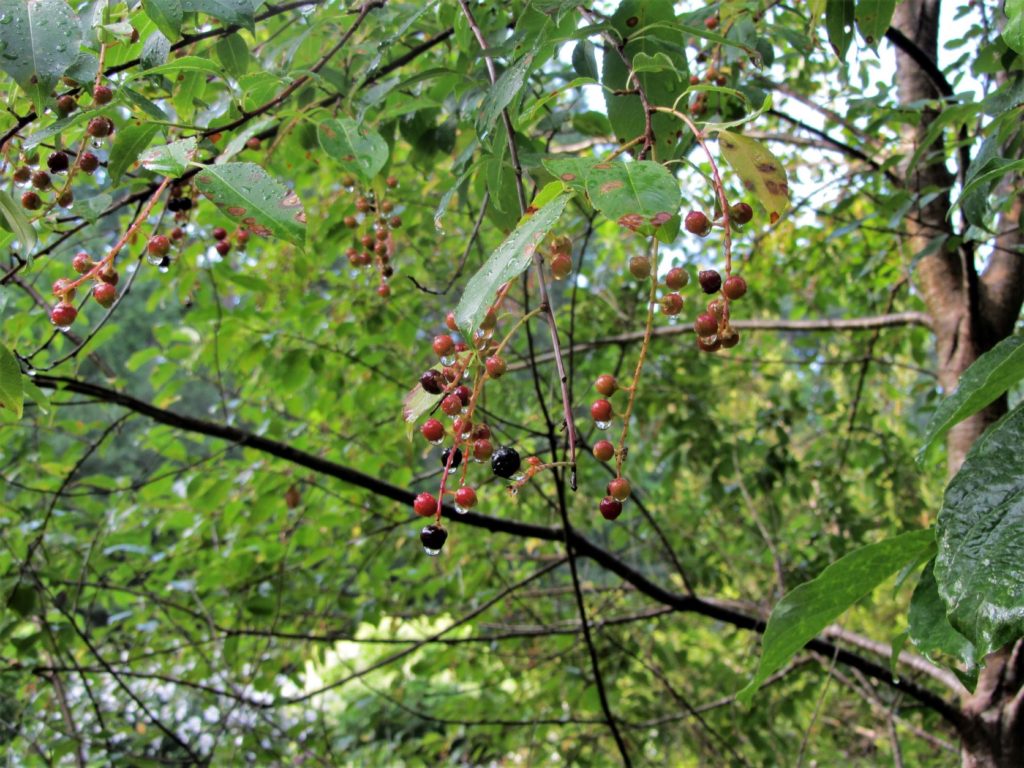
Native black cherries bloom with white flowers and their fruits turn black when ripe. These are edible cherries, but birds and squirrels often get to them first. Williamsburg Botanical Garden and Freedom Park Arboretum
Prunus serotina, Black Cherry, 40’-80’, grows slowly in shade, plant on the forest edge for best flowering, blooming, attracts pollinators, edible fruit, larval host plant, yellow autumn color, excellent for wildlife
Quercus coccinea, Scarlet Oak, 50′-80′, prefers upland locations with drier soil and excellent drainage, has a tap root, scarlet fall color, larval host plant, produces edible acorns, excellent for wildlife
Quercus michauxii, Swamp Chestnut Oak, 40’-60’, larval host plant, produces acorns, medicinal uses, excellent for wildlife
Quercus nigra, Water Oak, 50′-80′ tall, tolerates moist or dry soils, semi-evergreen, larval host plant, produces acorns, excellent for wildlife
Quercus palustris, Pin Oak, 50’-70’, prefers wetlands and full sun, not appropriate to include in an uplands forest, shallow root system, produces acorns, larval host plant, excellent for wildlife
Quercus virginiana, Live Oak, 40’-80’, broadleaf evergreen, winter interest, larval host plant, produces acorns, excellent for wildlife (This oak originally was native to our south, but has naturalized into our area in recent centuries.)
Salix nigra, Black Willow, 60’-80′, plant only in wetlands in full sun, not shade tolerant, flood tolerant, controls erosion, larval host plant, excellent for wildlife
Sassafras albidum, Sassafras, 20’-40’, prefers dry, well drained soil in upland locations, full to part sun, will not tolerate dense shade, tap root, suckers and spreads, blooming, attracts pollinators, dark blue fruits on female trees in summer, larval host plant, medicinal uses, excellent for wildlife
Taxodium distichum, Bald Cypress, 50’-70’, found in riparian swampy areas, requires moist soil and full sun, a deciduous conifer, russet fall color, tolerates wet soil, winter interest, excellent for wildlife

Hazel alder, Alnus serrulata, grows in the swamp at the WBG-FPA. Catkins and tiny cones develop in late winter.
Shrubs and Small Trees to 20’
Alnus serrulata, Alder, 10’- 20’, pioneer species, fixes nitrogen, grows in wet soil, controls erosion, winter interest, host plant, excellent for wildlife
Aronia arbutifolia, Red Chokeberry, 6’-10’, prefers moist soil, blooming, supports pollinators, clumps and spreads, attracts wildlife, edible fruit, fall color, winter interest, excellent for wildlife
Cephalanthus occidentalis, Buttonbush 5’-15’, pioneer species, prefers wet locations in full to part sun, clumps and spreads, tolerates flooding and standing water, blooming, attracts pollinators
Clethra alnifolia, Pepperbush, 3’-8’, blooming, attracts pollinators, clumps and spreads, tolerates wet soils
Cornus amomum, Silky Dogwood, 6’-15’, blooming, attracts pollinators, clumping, larval host plant, excellent for wildlife
Corylus americana, Hazelnut, 10’-16’, grows in well-drained soil in upland areas, suckering and thicket forming, produces edible nuts, fall color, winter interest, excellent for wildlife
Euonymus americanus, Strawberry-bush, 6’-10’, grows in well-drained soil in upland areas, clumps and spreads, drupes ripen to scarlet in autumn, scarlet autumn leaves, excellent for wildlife
Hydrangea quercifolia, Oak Leaf Hydrangea, 5′-8′, grows in moist but well-drained soil , multi-stemmed, blooming, flowers last into autumn, supports pollinators, scarlet fall foliage, excellent for wildlife. Oak leaf Hydrangea is not native to this region of Virginia but grows here very well with protection from deer.
Ilex verticillata, Winterberry Holly, 3’-12’ tall, prefers moist soils in full to part sun, attracts pollinators, showy scarlet drupes in fall and winter, winter interest, excellent for wildlife
Ilex vomitoria, Yaupon Holly, 2’-20’ (several different growth habits), rarely found in local forests, broadleaf evergreen, larval host plant, attracts pollinators, produces drupes, important to birds, winter interest, excellent for wildlife, medicinal uses, tea can be made from its leaves
Kalmia latifolia, Mountain laurel, 12’-20’, grows in upland forests in part shade, clumping, blooming, attracts pollinators, evergreen, prefers sloping, well-drained soil
Lindera benzoin, Spicebush, 6’-15’, prefers moist soil in full to part sun, fast growing, clumping, blooming, produces red drupes, larval host plant, excellent for wildlife
Myrica caroliniensis, Swamp Bayberry, 6’-8’, prefers moist, wetland locations in full to part sun, tolerates wet soils, clumping, evergreen, attracts pollinators, larval host plant, produces whitish-blue fruits in late summer, excellent for wildlife
Myrica cerifera, Southern Wax Myrtle, 15’-20’ tall, can grow in upland or wet locations, prefers full to part sun, clumping, evergreen, tolerates wet soils, attracts pollinators, larval host plant, produces blue fruits in late summer, excellent for wildlife
Persea palustris, Swamp Bay or Red Bay, 15’-20’, grows in wetlands and riparian areas, broadleaf evergreen, larval host plant, tolerates wet soils, produces blue fruit in fall, excellent for wildlife
Sambuncus canadensis, Elderberry 6’-12’ tall, blooming, clumping and spreading, tolerates wet soils, edible fruit, excellent for wildlife, medicinal uses
Viburnum dentatum, Arrowwood Viburnum, 3’-10’, clumping, blooming, dark blue fruit, attracts pollinators, fall color, winter interest, excellent for wildlife
Viburnum nudum, Possumhaw, 5’-20’, clumping, tolerates wet soils, blooming, blue-black fruit in late summer, attracts pollinators, fall color, winter interest, excellent for wildlife
Viburnum prunifolium, Black Haw, 12’-15’, single trunk tree, blooming, blue-black fruits in late summer, autumn color, protect from grazing deer, excellent for wildlife
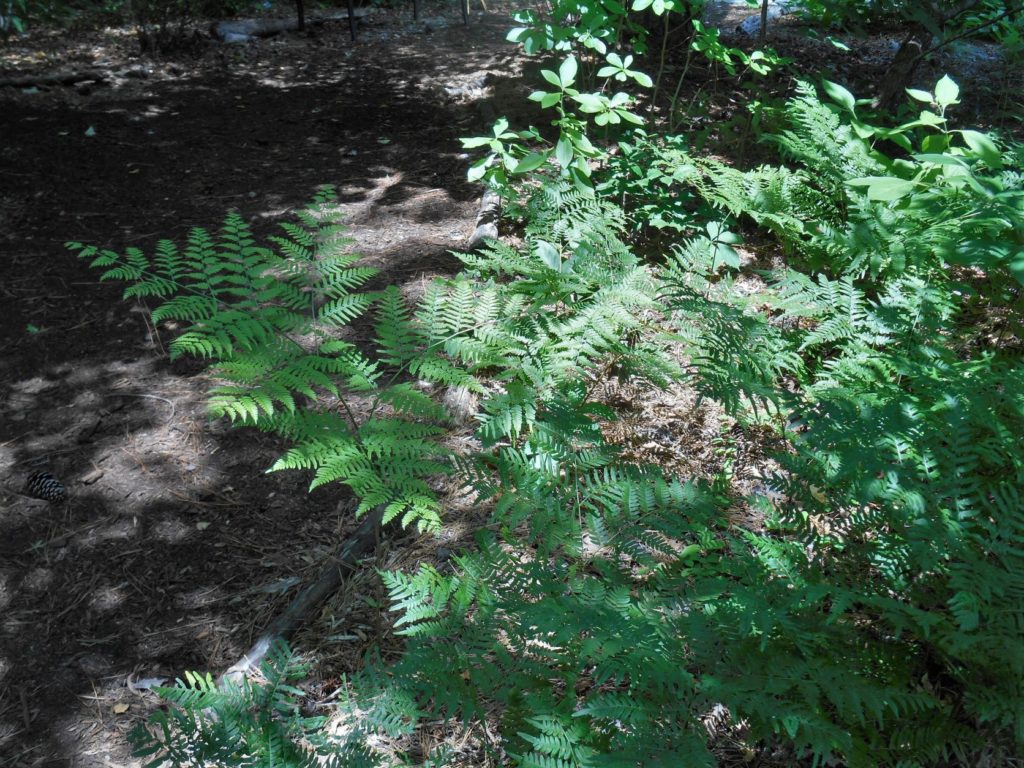
Bracken ferns grows along a path at the WBG-FPA. This fern spreads easily by rhizomes, making it a good choice to naturalize over a large area. It is deciduous.
Understory Shade Perennials for a Tiny Forest
Adiantum pedatum, Northern Maidenhair Fern
Arisaema triphyllum, Jack-in-the-Pulpit (toxic, very deer resistant)
Asarum canadens, Common Wild Ginger
Asplenium platyneuron, Ebony Spleenwort (fern)
Aureolaria virginica, Yellow false-foxglove (plant near a tree in the white oak group)
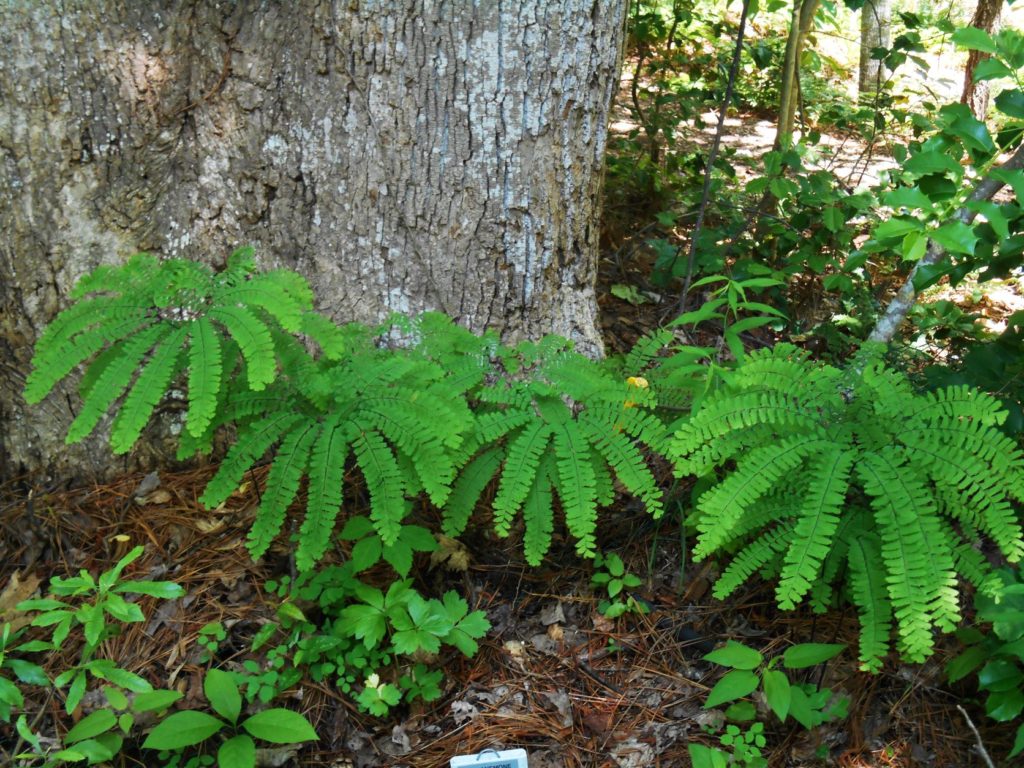
Northern maidenhair ferns, Adiantum pedatum, grow as ‘shoes and socks’ groundcover at the base of a tulip tree at the WBG-FPA. These ferns slowly spread on their rhizomes.
Hexastylis virginica, Wild Ginger
Homalosorus pycnocarpos, Glade Fern
Maianthemum racemosum, False Solomon’s seal
Medeola virginiana, Indian cumber-root
Mitchella repens, Partridgeberry (groundcover vine)
Pteridium latiusculum, Bracken Fern (prefers part sun)
Podophyllum peltatum, Mayapple
Polystichum aristichoides, Christmas Fern
Scutellaria elliptica and S. integrifolia, Hairy skullcap and helmet skullcap
Tiarella cordifolia, Foamflower
Trillium ssp., Wakerobin
Uvularia perfoliata and U. sessilifolia, Perfoliate bellwort, mountain bellwort
All photos by E. L. McCoy
Sources to Order Seedling Trees
Earth Sangha Native Plant Nursery (Springfield, VA)
Missouri Department of Conservation Seedling Nurseries
Virginia Department of Forestry Seedling Nurseries
To Learn More
Dirr, Michael A. Dirr’s Encyclopedia of Trees and Shrubs. 2016.
Lambe, Dan. Now Is the Time for Trees: Make an Impact by Planting the Earth’s Most Valuable Resource. 2022.
Lewis, Hannah and Paul Hawken. The Mini-Forest Revolution: Using the Miyawaki Method to Rapidly Rewild the World. Chelsea Green Publishing. 2022.
Pearce, Fred. A Trillion Trees: Restoring Our Forests by Trusting in Nature. Greystone Books. 2022.
Phillips, Michael. Mycorrhizal Planet: How Symbiotic Fungi Work with Roots to Support Plant Health and Build Soil Fertility. Chelsea Green Publishing. 2017.
Silver, Akiva and Samuel Thayer. Trees of Power, Ten Essential Arboreal Allies. Chelsea Green Publishing. 2019.
Stamets, Paul. Mycelium Running: How Mushrooms Can Help Save the World. Ten Speed Press. 2005
Stewart, Amy. The Tree Collectors: Tales of Arboreal Obsession. Random House. 2024.
Shrubsole, Gary. The Lost Rainforests of Britain. William Collins. 2022.
Tallamy, Douglas. Bringing Nature Home: How Native Plants Sustain Wildlife in Our Gardens. 2007.
Tree, Isabella. Wilding: Returning Nature to Our Farm. New York Review Books. 2019.
Tree, Isabella. The Book of Wilding: A Practical Guide to Rewilding Big and Small. Bloomsbury Publishing. 2023.
Related Articles on This Website
Cultivating a Tiny Forest (Part 1)
Beech, the Mother Tree, Queen of the Forest
Planting Trees and Other Hacks to Manage Wet Soils
Growing Indigenous Trees From Seeds
Identifying Local Trees in Winter
Eastern Red Cedar, An Uncommonly Useful Tree
Holly, King of the Winter Forest
Mountain Laurel a Native Shrub to Love
Myrica is Mostly for the Birds
The Bassett Trace Nature Trail

